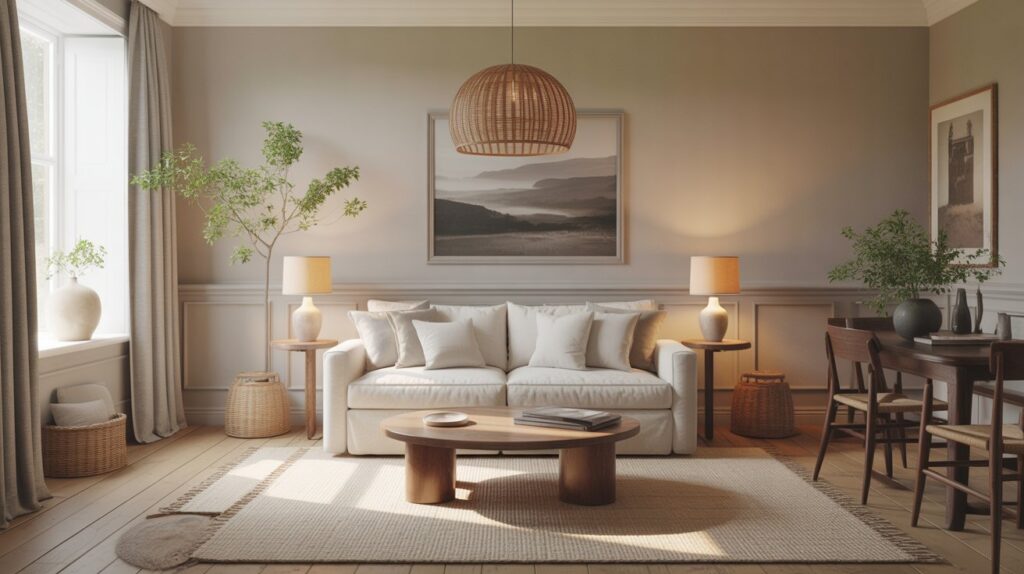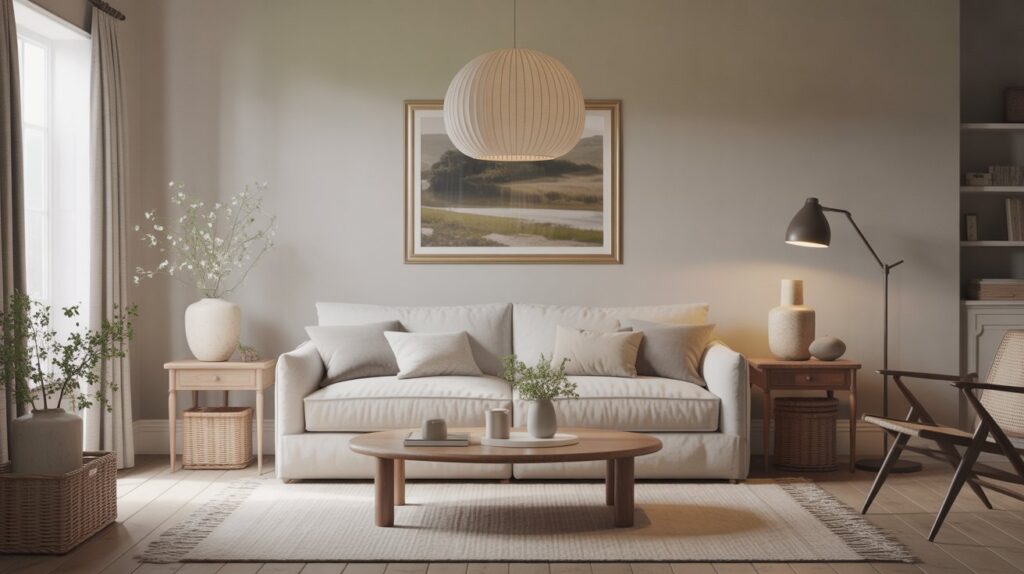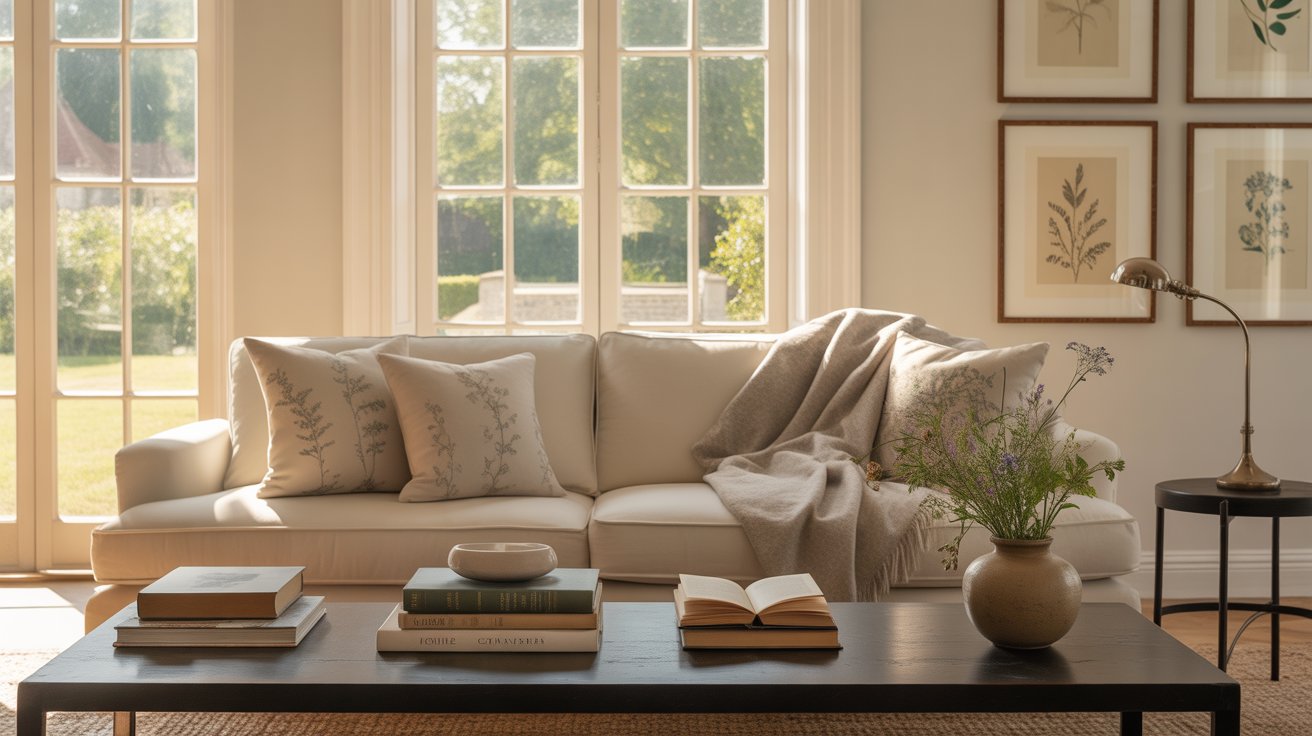Want a home that feels airy, calm and pared-back, yet warm, lived-in and full of character? You’re in the right place. This guide shows how to marry clean American minimalism with the cozy, textured charm of British country farmhouse style—without creating a style fight. Expect practical room-by-room strategies, fabric and palette recommendations, shopping & DIY tips, and interactive checklists so you can actually get this done.
Minimalist interior decorating — use it as your guiding principle: intentional, curated, and clutter-free, even when you bring in rustic accents.
Why this hybrid works (and why you’ll love it)
Minimalist interior decorating centers on restraint: a limited palette, carefully chosen furniture, and an emphasis on light and negative space. British country chic brings texture, heritage pieces, and a warm, welcoming vibe—think linen throws, worn oak tables, botanical prints, and layered rugs. Together, they create a home that reads as calm and modern from a distance, but close up reveals tactile depth and comforting detail. For a clear primer on minimalist design principles, Architectural Digest’s overview remains one of the best starting points. (Architectural Digest)
The overall game plan — 3 rules to follow
- Limit, then layer. Start by paring down to essentials (furniture, big art, a rug). Then add one or two rustic layers—an heirloom chest, an aged brass lamp, or a faded floral cushion.
- Pick one focal warmth per room. It could be a reclaimed oak dining table, a stone fireplace, or a linen-draped window seat. Keep the rest minimal.
- Respect scale and negative space. Farmhouse pieces can be visually heavy—balance them with airy storage, pale walls, and clean-lined lighting.

1 — Choose the right neutral palette (and how to add depth)
Minimalism doesn’t mean “white everywhere.” Aim for a layered neutral palette: warm off-whites, soft taupes, gentle greys and a grounding mid-brown. This creates a calm backdrop that lets a British country throw or a farmhouse ladder breathe without feeling lost.
Practical approach:
- Base: Soft white or warm eggshell for walls.
- Secondary: Pale greige or washed stone for larger furnishings.
- Anchor: One mid-tone (warm taupe or soft brown) for your focal furniture piece.
- Accent: Single colour pops in moss green, navy, or muted terracotta—used sparingly.
If you want reference palettes and professional color thinking, Livingetc’s pieces on minimalist palettes explain how to keep neutrals rich rather than flat. (Livingetc)
2 — Furniture pairing: sleek lines + soulful pieces
Mix a handful of minimal, modern silhouettes with one or two farmhouse anchors.
What to buy and where to place it:
- Modern base pieces (sofa, streamlined sideboard, simple bed frame): choose minimal profiles in neutral fabrics or matte finishes.
- Farmhouse anchors (reclaimed dining table, antique dresser, ladder shelf): place these centrally so they read as intentional features—not clutter.
- Balance with scale: a big farmhouse table pairs best with slim, modern dining chairs rather than chunky benches on every side.
Tip: if a room feels too “new”, bring in one small patinated object—an old skillet, a framed vintage botanical—so the space tells a story. The Spruce has great practical tips for marrying rustic charm with minimalist lines. (The Spruce)
3 — Fabrics & textures: the soft language of British country chic
Farmhouse warmth lives in textiles. But minimalism asks for restraint—so choose quality over quantity.
Fabric picks that sing together:
- Linen (washed or slubby): perfect for curtains, slipcovers, and casual cushions; it softens minimal lines without fuss. Linen is a farmhouse staple and works beautifully in neutral schemes.
- Wool & blended rugs: low-to-medium pile in natural tones add warmth underfoot without pattern noise.
- Cotton duck & canvas: hardy for dining chair covers or floor cushions—these speak farmhouse toughness in a minimal way.
- Subtle prints: opt for faded botanicals or tone-on-tone stripes only as accent cushions or one throw—never on large surfaces.
For a quick breakdown of farmhouse-friendly fabrics, see product and fabric guides that list linen, cotton duck and other durable options. (On Sutton Place)

4 — Art, accessories & styling: edit like a minimalist, display like a country host
A successful fusion looks curated—not staged. Use these micro-rules:
- Gallery restraint: pick 3–5 framed pieces max on a wall; use mattes and simple frames to keep edges clean. A single large botanical print over a pared sofa can feel both minimal and country-chic.
- Surface discipline: keep surfaces purposeful—one decorative object, a stack of design books, one plant. No busy vignettes.
- Use antiques as punctuation: an old candlestick or mortar and pestle placed alone on a shelf reads as an intentional pause.
- Textural contrast: pair a smooth plaster vase with a handwoven basket. This is where British rustic detail meets minimalist clarity.
Houzz’s essays on seasonal and minimalist decorating give lots of examples for keeping surfaces uncluttered while adding character. (Houzz)
5 — Lighting: sculptural simplicity with warm character
Lighting completes the mood. Aim for modern fixtures with warm finishes, or simple silhouettes with an antique touch.
Strategies:
- Statement pendent (clean form) over a farmhouse table: choose a single pendant with a matte finish or warm metal (aged brass) to bridge the styles.
- Layer with soft table lamps: lamps with linen shades give off cosy light; use them rather than many overheads.
- Accent strips & picture lights: minimal LED strips under shelves keep the look contemporary while highlighting rustic objects.
Architectural Digest’s recent minimalist room tours show how sculptural forms and natural finishes work together for calm, lived-in spaces. (Architectural Digest)
6 — Room-by-room blueprint: practical applications
Living Room
- Anchor: low-profile modern sofa in a neutral weave.
- Feature: reclaimed oak coffee table or antique trunk.
- Accessories: one or two woven baskets, a linen throw, and one sculptural lamp.
Kitchen / Dining
- Anchor: sleek cabinetry and open shelving (minimal).
- Feature: large farmhouse table or butcher’s block with modern pendant above.
- Textiles: canvas napkins, a single runner in a natural fibre.
Bedroom
- Anchor: simple upholstered bed frame.
- Feature: vintage chest or scalloped wood chair.
- Bedding: crisp white sheets, one washed-linen duvet, and a textured throw.
Hallways & Entry
- Keep it minimal: slim console, round mirror, and an antique tray for keys. A single plant or umbrella stand provides farmhouse practicality without clutter.

7 — Practical projects: three simple DIYs to cement the blend
- Minimal Ladder with Rustic Throws
Build or buy a slim ladder (painted matte black or white) and drape with worn linen throws—an instant farmhouse accent that’s tidy and sculptural. - Refinished Table with Modern Legs
Take an old farmhouse tabletop, sand and oil it, then attach slim metal hairpin legs for a hybrid dining/desk piece. - Framed Botanical Collage
Press leaves and flowers (or scan vintage prints), mount on neutral mattes and group three small frames in a row—heritage feeling, minimal presentation.
Sourcing & shopping — where to look (US & UK)
- Modern/minimal base pieces: look for Scandinavian, mid-century or Japandi inspired lines (online boutiques or local design stores).
- Farmhouse anchors & vintage finds: local antique fairs, flea markets, or curated vintage sellers. A single thrifted piece adds the soul an otherwise new room might miss.
- Textiles: buy quality linen and wool from reputable fabric retailers; these last and patina well.
If you want deeper reading about farmhouse fabrics, neutrals and practical tips for mixing, The Spruce and House & Garden have excellent, practical advice and examples. (The Spruce, House & Garden)
Interactive checklist — use this while you edit a room
- Clear out everything from the room that you don’t use regularly.
- Choose your base furniture (sofa/bed/table).
- Pick one farmhouse anchor (reclaimed wood / antique).
- Limit palette to 3 neutrals + 1 accent.
- Add two layered textiles (rug + throw) and one vintage object.
- Final edit: remove any item that doesn’t pass the “does this bring calm or story?” test.
Share a before/after photo with the tag #TransatlanticTrends — I’ll pick five reader rooms to feature and give a short styling tip.

Common mistakes & how to avoid them
- Mistake: piling several heavy farmhouse pieces in one small room.
Fix: choose a single anchor and keep other furniture streamlined. - Mistake: over-patterning.
Fix: if you love florals, choose one medium-scale print and balance it with plain linens. - Mistake: ignoring scale.
Fix: match the visual weight of farmhouse items with airy, minimal companions (glass, matte metal).
Final encouragement: make it liveable, not museum-perfect
Minimalist interior decorating fused with country chic is about editing with warmth. The goal: spaces that look calm on arrival, but reward touch and time. Keep the editing ruthless, the textiles soft, and the stories honest—family heirlooms, a found vase, or a well-used chopping board are all welcome.
Further reading (authoritative resources)
For deeper practical guides and inspiration, check these reputable resources:
- Architectural Digest — Minimalist Interior Design: Everything You Need to Know. (Architectural Digest)
- House & Garden — English Country House Style: history and how to get it. (House & Garden)
- The Spruce — How To Turn Your Home Into a Minimalist Farmhouse. (The Spruce)
- Houzz — Mini Guide to Minimalism (practical room examples). (Houzz)
- Livingetc — Designers agree on the perfect minimalist color palette. (Livingetc)
(Each link above goes to a stable, reputable page that’s useful for deeper, hands-on guidance.)
Disclaimer: This post offers design ideas and general guidance. For structural changes, electrical work, or major renovations, consult qualified professionals. All product suggestions are illustrative; check local availability and measurements before purchasing. All images used in this article are royalty‑free or licensed for commercial use and are provided here for illustrative purposes.
